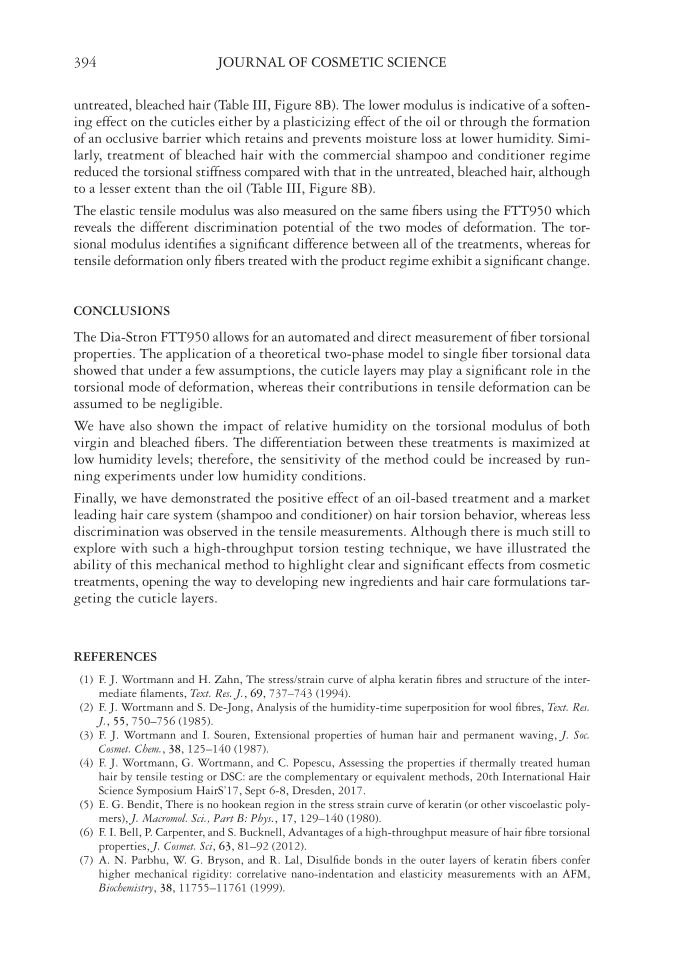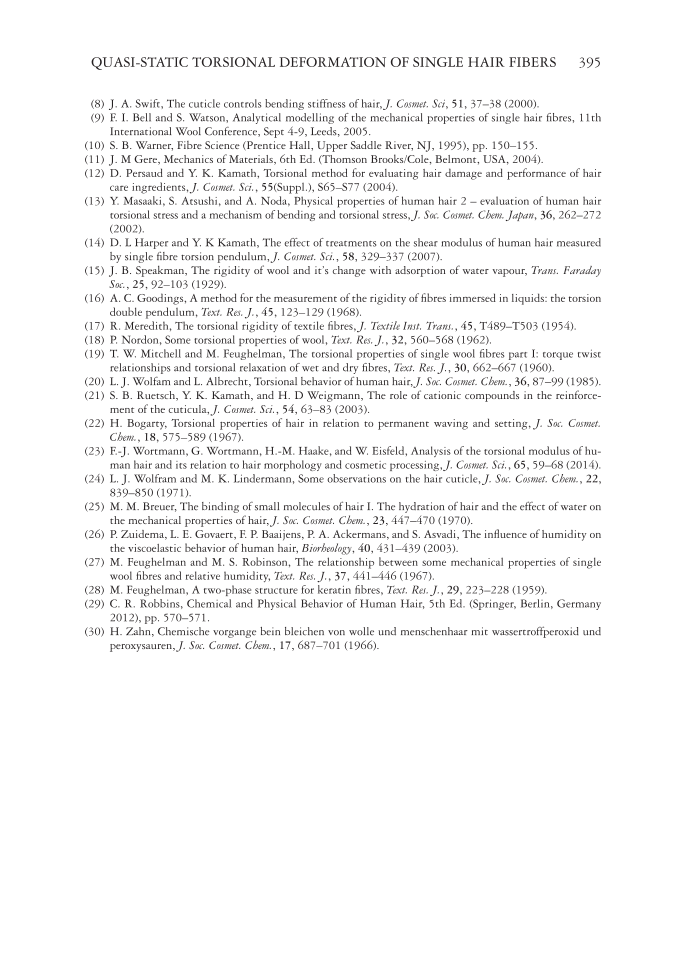JOURNAL OF COSMETIC SCIENCE 394 untreated, bleached hair (Table III, Figure 8B). The lower modulus is indicative of a soften- ing effect on the cuticles either by a plasticizing effect of the oil or through the formation of an occlusive barrier which retains and prevents moisture loss at lower humidity. Simi- larly, treatment of bleached hair with the commercial shampoo and conditioner regime reduced the torsional stiffness compared with that in the untreated, bleached hair, although to a lesser extent than the oil (Table III, Figure 8B). The elastic tensile modulus was also measured on the same fi bers using the FTT950 which reveals the different discrimination potential of the two modes of deformation. The tor- sional modulus identifi es a signifi cant difference between all of the treatments, whereas for tensile deformation only fi bers treated with the product regime exhibit a signifi cant change. CONCLUSIONS The Dia-Stron FTT950 allows for an automated and direct measurement of fi ber torsional properties. The application of a theoretical two-phase model to single fi ber torsional data showed that under a few assumptions, the cuticle layers may play a signifi cant role in the torsional mode of deformation, whereas their contributions in tensile deformation can be assumed to be negligible. We have also shown the impact of relative humidity on the torsional modulus of both virgin and bleached fi bers. The differentiation between these treatments is maximized at low humidity levels therefore, the sensitivity of the method could be increased by run- ning experiments under low humidity conditions. Finally, we have demonstrated the positive effect of an oil-based treatment and a market leading hair care system (shampoo and conditioner) on hair torsion behavior, whereas less discrimination was observed in the tensile measurements. Although there is much still to explore with such a high-throughput torsion testing technique, we have illustrated the ability of this mechanical method to highlight clear and signifi cant effects from cosmetic treatments, opening the way to developing new ingredients and hair care formulations tar- geting the cuticle layers. REFERENCES (1) F. J. Wortmann and H. Zahn, The stress/strain curve of alpha keratin fi bres and structure of the inter- mediate fi laments, Text. Res. J., 69, 737–743 (1994). (2) F. J. Wortmann and S. De-Jong, Analysis of the humidity-time superposition for wool fi bres, Text. Res. J., 55, 750–756 (1985). (3) F. J. Wortmann and I. Souren, Extensional properties of human hair and permanent waving, J. Soc. Cosmet. Chem., 38, 125–140 (1987). (4) F. J. Wortmann, G. Wortmann, and C. Popescu, Assessing the properties if thermally treated human hair by tensile testing or DSC: are the complementary or equivalent methods, 20th International Hair Science Symposium HairS’17, Sept 6-8, Dresden, 2017. (5) E. G. Bendit, There is no hookean region in the stress strain curve of keratin (or other viscoelastic poly- mers), J. Macromol. Sci., Part B: Phys., 17, 129–140 (1980). (6) F. I. Bell, P. Carpenter, and S. Bucknell, Advantages of a high-throughput measure of hair fi bre torsional properties, J. Cosmet. Sci, 63, 81–92 (2012). (7) A. N. Parbhu, W. G. Bryson, and R. Lal, Disulfi de bonds in the outer layers of keratin fi bers confer higher mechanical rigidity: correlative nano-indentation and elasticity measurements with an AFM, Biochemistry, 38, 11755–11761 (1999).
QUASI-STATIC TORSIONAL DEFORMATION OF SINGLE HAIR FIBERS 395 (8) J. A. Swift, The cuticle controls bending stiffness of hair, J. Cosmet. Sci, 51, 37–38 (2000). (9) F. I. Bell and S. Watson, Analytical modelling of the mechanical properties of single hair fi bres, 11th International Wool Conference, Sept 4-9, Leeds, 2005. (10) S. B. Warner, Fibre Science (Prentice Hall, Upper Saddle River, NJ, 1995), pp. 150–155. (11) J. M Gere, Mechanics of Materials, 6th Ed. (Thomson Brooks/Cole, Belmont, USA, 2004). (12) D. Persaud and Y. K. Kamath, Torsional method for evaluating hair damage and performance of hair care ingredients, J. Cosmet. Sci., 55(Suppl.), S65–S77 (2004). (13) Y. Masaaki, S. Atsushi, and A. Noda, Physical properties of human hair 2 – evaluation of human hair torsional stress and a mechanism of bending and torsional stress, J. Soc. Cosmet. Chem. Japan, 36, 262–272 (2002). (14) D. L Harper and Y. K Kamath, The effect of treatments on the shear modulus of human hair measured by single fi bre torsion pendulum, J. Cosmet. Sci., 58, 329–337 (2007). (15) J. B. Speakman, The rigidity of wool and it’s change with adsorption of water vapour, Trans. Faraday Soc., 25, 92–103 (1929). (16) A. C. Goodings, A method for the measurement of the rigidity of fi bres immersed in liquids: the torsion double pendulum, Text. Res. J., 45, 123–129 (1968). (17) R. Meredith, The torsional rigidity of textile fi bres, J. Textile Inst. Trans., 45, T489–T503 (1954). (18) P. Nordon, Some torsional properties of wool, Text. Res. J., 32, 560–568 (1962). (19) T. W. Mitchell and M. Feughelman, The torsional properties of single wool fi bres part I: torque twist relationships and torsional relaxation of wet and dry fi bres, Text. Res. J., 30, 662–667 (1960). (20) L. J. Wolfam and L. Albrecht, Torsional behavior of human hair, J. Soc. Cosmet. Chem., 36, 87–99 (1985). (21) S. B. Ruetsch, Y. K. Kamath, and H. D Weigmann, The role of cationic compounds in the reinforce- ment of the cuticula, J. Cosmet. Sci., 54, 63–83 (2003). (22) H. Bogarty, Torsional properties of hair in relation to permanent waving and setting, J. Soc. Cosmet. Chem., 18, 575–589 (1967). (23) F.-J. Wortmann, G. Wortmann, H.-M. Haake, and W. Eisfeld, Analysis of the torsional modulus of hu- man hair and its relation to hair morphology and cosmetic processing, J. Cosmet. Sci., 65, 59–68 (2014). (24) L. J. Wolfram and M. K. Lindermann, Some observations on the hair cuticle, J. Soc. Cosmet. Chem., 22, 839–850 (1971). (25) M. M. Breuer, The binding of small molecules of hair I. The hydration of hair and the effect of water on the mechanical properties of hair, J. Soc. Cosmet. Chem., 23, 447–470 (1970). (26) P. Zuidema, L. E. Govaert, F. P. Baaijens, P. A. Ackermans, and S. Asvadi, The infl uence of humidity on the viscoelastic behavior of human hair, Biorheology, 40, 431–439 (2003). (27) M. Feughelman and M. S. Robinson, The relationship between some mechanical properties of single wool fi bres and relative humidity, Text. Res. J., 37, 441–446 (1967). (28) M. Feughelman, A two-phase structure for keratin fi bres, Text. Res. J., 29, 223–228 (1959). (29) C. R. Robbins, Chemical and Physical Behavior of Human Hair, 5th Ed. (Springer, Berlin, Germany 2012), pp. 570–571. (30) H. Zahn, Chemische vorgange bein bleichen von wolle und menschenhaar mit wassertroffperoxid und peroxysauren, J. Soc. Cosmet. Chem., 17, 687–701 (1966).
Purchased for the exclusive use of nofirst nolast (unknown) From: SCC Media Library & Resource Center (library.scconline.org)









































































































